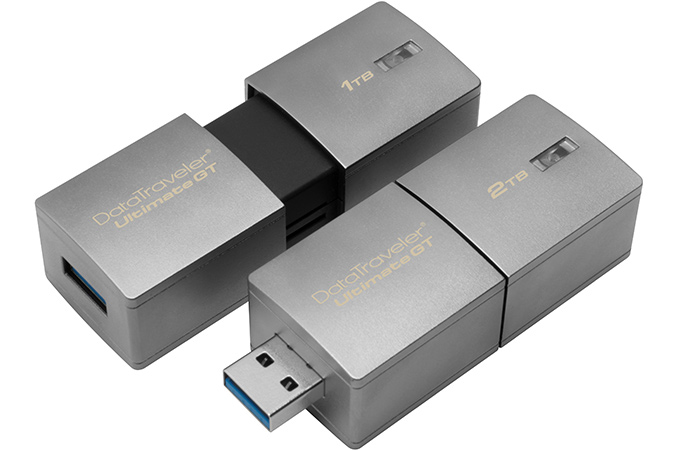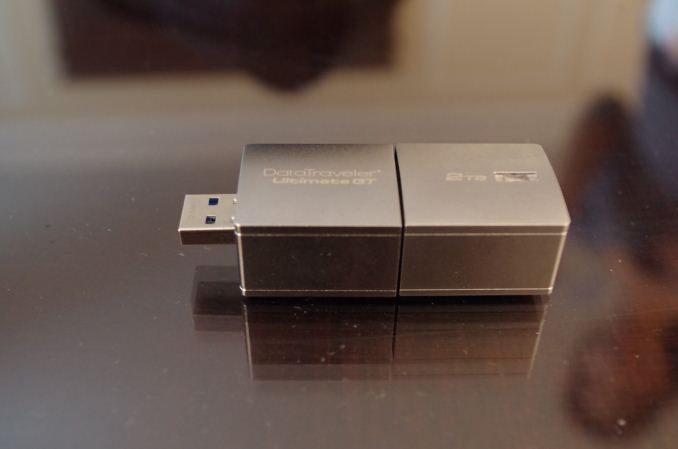Kingston Launches DataTraveler Ultimate GT USB Flash Drive with 2 TB Capacity
by Anton Shilov on January 12, 2017 5:00 PM EST- Posted in
- Flash Drive
- Storage
- Kingston
- Trade Shows
- CES 2017
- DataTraveler

Kingston this week introduced its new DataTraveler Ultimate GT USB flash drive with a re-freshed design and up to 2 TB capacity. The new devices are designed for those who need to store large collections of multimedia files.
The new Kingston DataTraveler Ultimate GT family of flash drives consists of 1 TB and 2 TB models with a USB 3.0 Type-A connector. The drives come in zinc-alloy metal enclosures to protect from physical damage and are relatively compact for their capacities (at least, more compact than external HDDs or SSDs). The new storage devices feature exactly two times higher capacity than their predecessors, the Kingston DataTraveler HyperX Predator 3.0 (512 GB and 1 TB) drives, introduced four years ago at CES 2013. What is unclear is whether they beat their ancestors in terms of performance (up to 240 MB/s read and 160 MB/s write), but keep in mind that the real-world transfer rate of the USB 3.0 interface is around 400 MB/s at best.
| Kingston DataTraveler Ultimate GT Family of Flash Drives | ||||
| DTUGT/1TB | DTUGT/2TB | |||
| Capacity | 1 TB | 2 TB | ||
| Type of NAND | Unknown | |||
| Maximum Transfer Rate | 5 Gbps | |||
| Dimensions | 72mm × 26.94mm × 21mm | |||
| Operating Temperature | -25°C to 60°C | |||
| Storage Temperature | -40°C to 85°C | |||
| Warranty | Five Years | |||
The DataTraveler Ultimate GT USB flash drives will be primarily useful for people who need to carry large amounts of data, but not necessarily edit it. For example, photographers, construction workers or scientists may offload images/videos/documents from their notebooks to such drives just for backup reasons. In fact, keeping in mind that many of such folks may work in harsh environments, the DataTraveler Ultimate GT drives are rated to support extended storage and operating temperature ranges: they can be stored at -40°C and operate at -25°C (-20°C and 0°C for typical USB drives).
Kingston will start to ship the new DataTraveler Ultimate GT USB flash drives in February and the storage devices will be covered with the company’s five-year warranty. The drives will work with any modern Microsoft Windows OS that supports such flash drives (Windows 7 SP1 and later), Apple MacOS (10.9.x and later), Linux (2.6.x and later) as well as Google’s Chrome OS. As for pricing the DataTraveler Ultimate GT USB flash drives are expected to have a price premium given their positioning. For example, the DataTraveler HyperX Predator 1 TB still costs well over $1000 at retailers like Amazon and Newegg.
It will also come with a carry pouch and a USB cable to alleviate issues where it interferes with other ports:
Source: Kingston













21 Comments
View All Comments
kaidenshi - Thursday, January 12, 2017 - link
If I need to move that much data using a high speed connection, I'm going to pay one third as much and get a $25 m.2 > USB adapter[1] and a $300 1TB m.2 SSD. If I avoid NVMe, the costs stays low and I have the same data throughput as the Kingston device. Maybe my solution isn't as "rugged", but throw it in a laptop bag and it's just as safe as the laptop I'll connect it to.[1] https://www.amazon.com/ZTC-Enclosure-Adapter-Super...
vladx - Thursday, January 12, 2017 - link
That would be a waste of a SSD unless the enclosure has TRIM support and those that have it are >$80. Still cheaper than these premium flash drives but still not that cheap.skavi - Thursday, January 12, 2017 - link
https://www.amazon.com/gp/aw/d/B01LXI5O01/ref=mp_s...This one is $20.
iamlilysdad - Thursday, January 12, 2017 - link
Well that was a shallow rabbit hole.I couldn't seem to find a "cheap" USB-C, USB3.1 10Gbps enclosure with TRIM support.
BrokenCrayons - Friday, January 13, 2017 - link
The loss of TRIM might not be a big problem for external storage devices where data is written infrequently.vladx - Friday, January 13, 2017 - link
Data is written infrequently on flash drives? Lol what are you smoking, I'm using my 64GB usb drive daily to exchange data between devices.BrokenCrayons - Sunday, January 15, 2017 - link
Even daily data transfers account for a lot less write activity than a SSD would experience when used as a system drive. There's a LOT of write activity being done behind the scenes that's transparent to the user (file modification date, paging, logging, etc) so even with very frequent writes on an external drive, the demand is usually still much lower.vladx - Sunday, January 15, 2017 - link
Lol you can't be serious. A system doing OS maintanence is writing much less than the 10-30 GB I'm writing everyday on my flash drive.BrokenCrayons - Tuesday, January 17, 2017 - link
Hello imaginary corner case invented just to have a reason to be objectionable in the comments box of an article.vladx - Monday, January 23, 2017 - link
Sorry that you can't imagine something so simple.